Marshmallow
Fuzzy Outside and Slippery Inside.
At weedom, the edible and medicinal marshmallow, Althea officinalis, has become a true (and therefore honored) weed. Sadly one had to be removed from one of the needed paths through the weeds, and, ‘shame to waste!’, it was harvested for all of its goodies, from roots to seeds. The entirety of this plant is edible for humans and quite palatable if harvested at the appropriate times. A related plant, Malva parviflora, the ‘small flowered marshmallow’ of of Australia is implicated in producing the staggers, toxicity in lambs, though full grown sheep are less affected. This appears to be a dose related toxicity. Goats seem to tolerate the weed better, though it seems to affect the ever sensitive horses, particularly young ones, similarly to the sheep. The (more discerning) cattle avoid this plant as well as the common mallow of North America.
Even though these roots aren’t at their prime, as they would be during the late fall or very early spring, even the most fibrous parts give off considerable amounts of the slippery demulcent goodness for which they’re best known. They’re a lot dryer and harder to cut than they’d be during the wetter and cooler seasons. The crown root of the plant that was sacrificed, had 4 concentric rings, suggesting that it had survived beneath the ground for at least a few years.
For years, the marshmallow has been growing and spreading in a semi-shaded area south of our greenhouse. We’ve been eating the leaves, harvesting and drying more of them, and waiting for the time that we’d reliably have enough roots to commit to a new line of soap products. (We expect to produce those bars this coming spring).
Knowing that you all love Linnaean plant names :-D let’s do some Botany! First of all Marshmallow, is another member of the family Malvaceae, along with the Hollyhocks, Alcea rosea and the common mallow, Malva neglecta , which were featured in earlier weedom posts, as well as hibiscus, okra and cotton plants. This family also includes the (delicious!) durian, baobab and cacao trees. Native to Europe, Western and Northern Asia, it has been imported to North America, and is seen in the eastern regions most densely.
The perennial marshmallow occupies USDA hardiness zones 3-9. In our zone 6, the plant sheds its leaves with the frost, leaving bare woody stems which mark the place where new shoots will reappear next Spring. It prefers partial shade and persistently damp areas, and reaches 6 or more feet in height in those happy locations. It’s also salt tolerant, and can be found in coastal areas.
Leaves are simple, with a sort of maple leaf shape except that there are 3 main lobes, not 5. They are quite hairy, above and below, as are their petioles, which emerge from the supporting, hairy stems in alternating fashion. Of our common weeds, this plant is perhaps third behind mullein and lambs ear for hair density. Veins are arranged palmately, and are quite prominent on the underside of the leaf.
Flowers emerge in groups on racemes. They have 5 hairy sepals, 5 petals, and numerous anthers atop stamens that are fused at the base into a tube, which surrounds the lower portion of the female structures. The whole array of anthers and stigma at the top resemble a bunch of flowers in a vase, and it’s a distinctive feature of blooms in the mallow family.
Seeds are arranged as segments resembling a cheese wheel within the seed pod. This has given rise to the cheeses name of this edible delicacy, as well as a nickname for the plant. It’s about a quarter inch, 0.8cm in diameter.
The extensive roots of marshmallow are surrounded by a thin, light brown bark, which strips off rather easily, revealing the highly slippery, white, fibrous inner tissue which is the source of much starch, pectin and mucilaginous material. Much of harvested marshmallow root still retains the root bark, and therefore more full nutritional value.
In ancient times, marshmallow, and related species provided food in good times and in bad. The leaves were eaten cooked or raw. Egyptians, Romans and the inhabitants of Syria incorporated this plant into their diet. The youngest leaves are even considered a delicacy. Marshmallow leaves are amazingly mild and palatable, with the demulcent, slippery constituents taming the fuzz, that might otherwise be offputting to some. This plant as both food and fodder is visible in the writings of Romans, Horace (who found it Ode-worthy) and Virgil. Roots were boiled, then fried with other ingredients. These have long served as a supportive preparation, particularly in times of crop failure.
One might think that the soothing demulcent character of marshmallow would affect only the tissues with which it has direct contact, but the beneficial components of this plant seem exert their influence farther afield, to the bladder, kidneys, liver, lungs, and to injured tissues throughout the body. How this is occurs, if one accepts that the demulcent mix of polysaccharides is poorly absorbed, is not understood, and is likely due to multiple indirect and direct mechanisms. Despite it’s millennials old healing reputation (conveyed in the very name Althea, from the Greek word to heal), there is a paucity of rigorous research in the U.S., and one must look to the Mid East and Asia.
One of the alternate names for marshmallow is ‘mortification root’. (Nope, this isn’t about the more extreme religious practices for the purpose of expiating fleshly desires and tendencies. ) The older usage of ‘mortification’ referred to the process of gangrene in wounded tissue, which mallow has long been used to prevent! Dr. Patrick Jones, DVM reports great success in wound care using various mallows topically and internally in animals and humans, and considers marshmallow root the easiest to use. He says that the beginning signs of impending gangrene can be reversed using aqueous suspensions made with the mallows. Additionally he reports these treatments healing damage of lower extremities from diabetes. The gel, which forms as marshmallow root constituents take up water, serves as a natural protectant to wounds both externally and internally. (Modern medicine makes use of various hydrogel imitators of marshmallow in wound care.) Added benefits are conferred by the antimicrobial, immune modulating and anti-inflammatory constituents found in these plants. Marshmallow has a long and successful history in addressing ulcers and inflammations of the GI tract, of interstitial cystitis, as well as irritations and inflammations of the lungs. Those with chronic skin ulcers of the extremities might do well to grind up these roots, put them in cool water and use to soak the afflicted body part.
Marshmallow water has a long tradition of use to calm coughs, and soothe the lungs. A human clinical trial of an Althea officinalis extract “40 mg”, three times daily by mouth, was reported to inhibit coughs brought about by the use of ACE inhibitors. Anti-inflammatory mechanisms and suppression of NO production were proposed as mechanisms.
Most herbalists agree that the full demulcent benefits are best retained if the water used to soak the roots is either cold, or not very hot. While the starches and pectin retain more of their properties with the heat, the integrity of the mucilage is more easily disrupted. On the other hand, there are numerous beneficial compounds present in the leaves, particularly flavonoids and antimicrobial constituents, which are extracted with hotter water, or with less polar solvents.
Root components present in the healing gel.
Pectin 11% a sort of helical structure comprised of galacturonic acid molecules or methyl esters of the same. Interspersed within these structures are other sugar monomers such as galactose, glucose, mannose, xylose and arabinose. Pectins bind to each other and to other molecules and ions in a solution.
Mucilage 5-35% mix of large polymers comprised primarily of L-rhamnose, D-glactose, D galacturonic acid, and D-glucuronic acid.
Starch 25-30% large polymers of glucose molecules connected by glycosidic bonds.
Various sugars, tannins and flavonoids within the roots and found in flowers leaves and stems confer additional wound healing, antibacterial, and antifungal benefits. Some of these include
flavonoids such as hypolaetin-8-glucoside, isoquercitrin, kaempferol,
phenolic acids such as caffeic acid, 4-hydroxycinnamic acid, ferulic acid, p-hydroxybenzoic acid, salicylic acid, p-hydroxyphenylacetic acid, vanillic acid
coumarins such as scopoletin
phytosterols and tannins ,
a good deal of asparagine, and other amino acids
Marshmallow is employed as an vulnerary ingredient in many poultice formulations which contain such herbs as plantain, calendula and comfrey, in order to speed healing. In a collaboration with
, we supplied an example of such a recipe for care of the oral mucosa.The blood sugar lowering quality of the mallow family is related to inhibitory action on bodily enzymes which break down polysaccharides, as well ability of the mucilage to slow absorption of sugars. By this means, spikes in blood sugar after meals are reduced. Intraperitoneal adminstration of the marshmallow extract in non-diabetic mice has resulted in significant lowering of blood glucose levels, likely by some other mechanism.
Research on the immune modulating properties of polysaccharides has opened up, in response to observations that these components in various mushrooms and plants seem to inhibit tumors in vivo. Additionally there are studies of Althea officinalis, showing that tumor cell lines are inhibited by the root polysaccharide extracts in vitro. The thought of tumor suppressive therapies that don’t make people sick is incredibly exciting.
The safety profile of mallow is befitting a medicine that is also food. Human toxicity would be something on the order of water. The only caveat is the possibility that medicinal doses of this herb could sequester pharmaceuticals, and either delay or lower their absorption. A little tea would not be an issue, but large amounts taken by mouth should be taken at different times than other meds.
Last, but not least, we refer you to the Scienchef at FoodCrumbles.com, who has developed an actual, true, marshmallow recipe, using powdered Althea officinalis root and no gelatin. This exhibits the timing and temperature controlling skill that is required of successful candy makers.
We know lots of you have worked with the incredible marshmallow and its relatives. We’d like to learn you’re doing with it!
Where We Dig
1. Sadighara P, Gharibi S, Moghadam Jafari A, Jahed Khaniki G, Salari S. The antioxidant and Flavonoids contents of Althaea officinalis L. flowers based on their color. Avicenna J Phytomed. 2012;2(3):113-117.
2. Adamant A. Practical Self Reliance | Ashley Adamant | Substack. Accessed August 5, 2024. https://ashleyadamant.substack.com/embed
3. Shah SMA, Akhtar N, Akram M, et al. Pharmacological activity of Althaea officinalis L. J Med Plants Res.
4. (PDF) The Pharmaceutical importance of Althaea officinalis and Althaea rosea: A review. Accessed August 5, 2024. https://www.researchgate.net/publication/285919150_The_Pharmaceutical_importance_of_Althaea_officinalis_and_Althaea_rosea_A_review
5. Grieve M. Modern Herbal. Echo Point Books & Media, LLC.; 2015. https://openlibrary.org/books/OL36722889M/Modern_Herbal
6. Hoffmann D. Medical Herbalism: The Science and Practice of Herbal Medicine. Healing Arts Press; 2003.
7. Marshmallow plant characteristics. Botanical online. January 19, 2019. Accessed August 5, 2024. https://www.botanical-online.com/en/botany/marshmallow
8. Marshmallow Monograph. HerbRally. Accessed August 5, 2024. https://www.herbrally.com/monographs/marshmallow
9. Marshmallow intoxication. Accessed August 5, 2024. http://www.flockandherd.net.au/sheep/ireader/marshmallow-intoxication.html
10. CABI. Malva neglecta (common mallow). CABI Compendium. 2021;CABI Compendium:115482. doi:10.1079/cabicompendium.115482
11. Malva neglecta (Buttonweed, Cheese Plant, Cheeseweed, Common Mallow, Dwarf Mallow, Mallow) | North Carolina Extension Gardener Plant Toolbox. Accessed August 5, 2024. https://plants.ces.ncsu.edu/plants/malva-neglecta/
12. Rasheed H, Nawaz H, Rehman R, Mushtaq A, Khan S, Azeem W. Little Mallow: A review of botany, composition, uses and biological potentials. Published online January 1, 2017:157-161.
13. Xue T, Ruan K, Tang Z, Duan J, Xu H. Isolation, structural properties, and bioactivities of polysaccharides from Althaea officinalis Linn.: A review. International Journal of Biological Macromolecules. 2023;242:125098. doi:10.1016/j.ijbiomac.2023.125098
14. Albert S. How to Grow Althaea - Marsh Mallow. Harvest to Table. January 24, 2022. Accessed August 5, 2024. https://harvesttotable.com/how-to-grow-althaea/
15. Foraging Marshmallow (Althea sp.). Practical Self Reliance. April 15, 2024. Accessed August 5, 2024. https://practicalselfreliance.com/marshmallow-althea-sp/
16. Hassan I, Gani A, Ahmad M, Banday J. Extraction of polysaccharide from Althea rosea and its physicochemical, anti-diabetic, anti-hypertensive and antioxidant properties. Sci Rep. 2022;12(1):17116. doi:10.1038/s41598-022-20134-6
17. Effect of Althaea Officinalis on Cough Associated with ACE Inhibitors. doi:10.3923/pjn.2007.256.258
18. Dehydrating Marshmallow Root. From Harvest to Powder! September 13, 2023. Accessed August 5, 2024. https://dehydratorlab.com/dehydrating-marshmallow-root/
19. Can Goats Eat Marshmallow Weed? (Good or Bad) | Goat Guardian. December 3, 2023. Accessed August 5, 2024. https://goatguardian.com/can-goats-eat-marshmallow-weed/



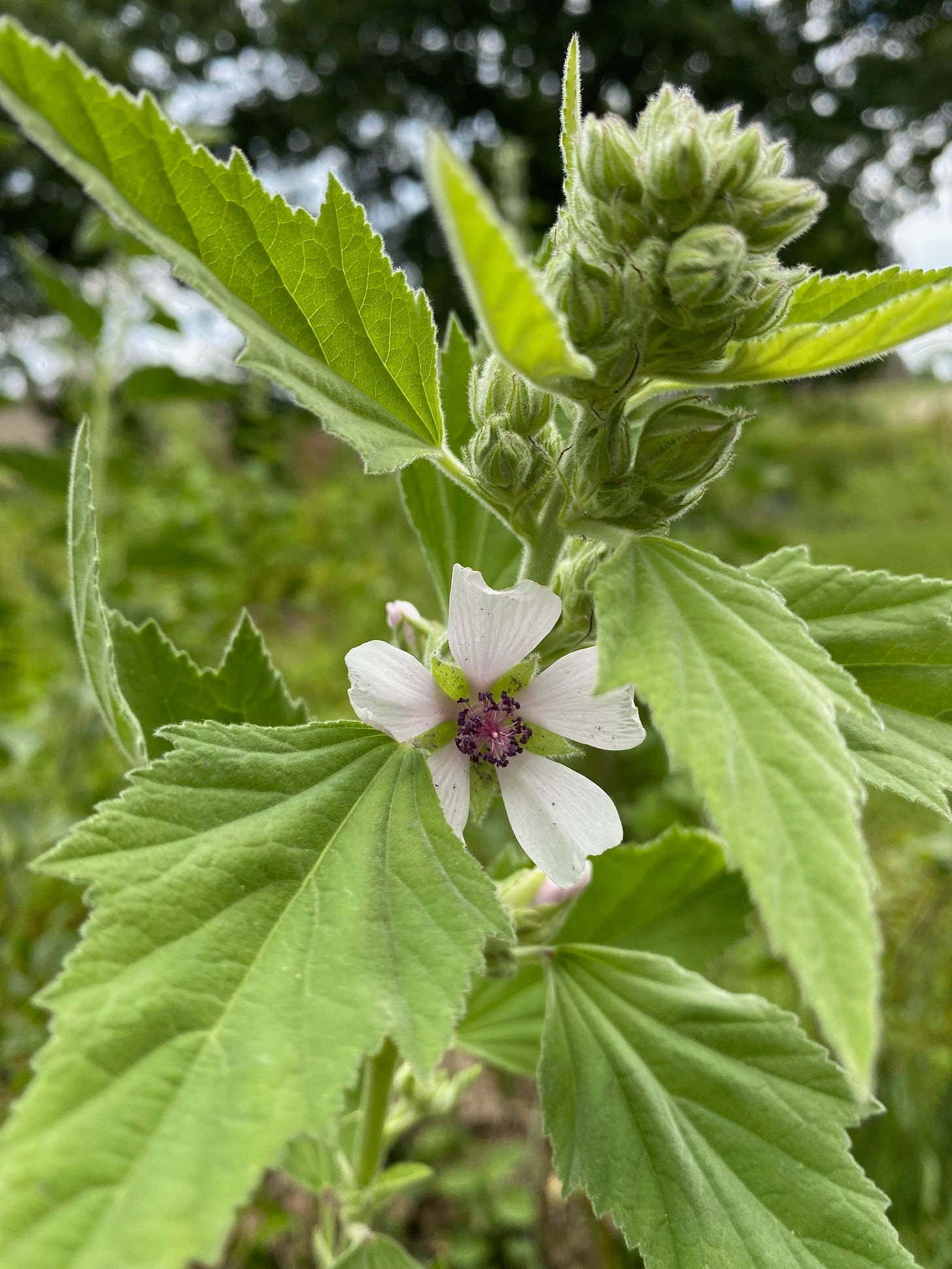
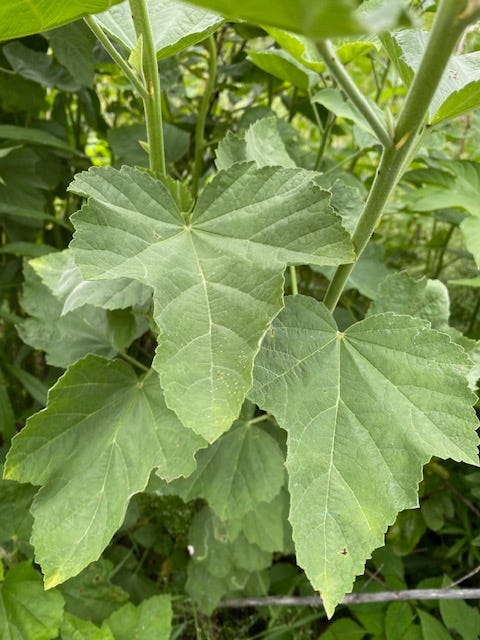
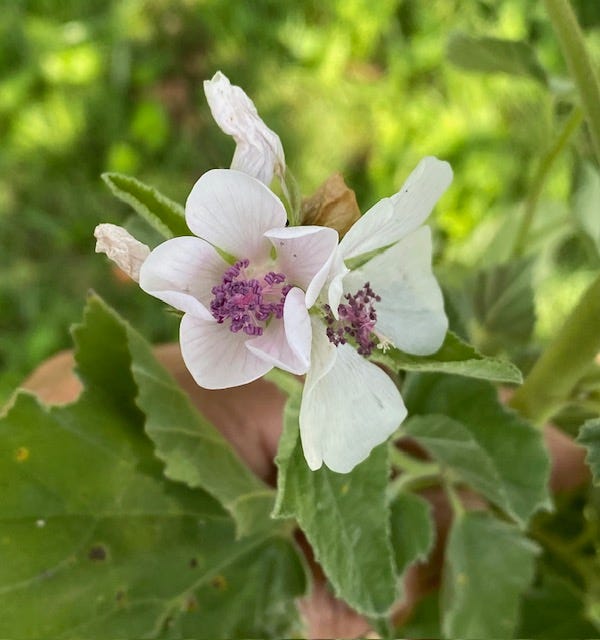
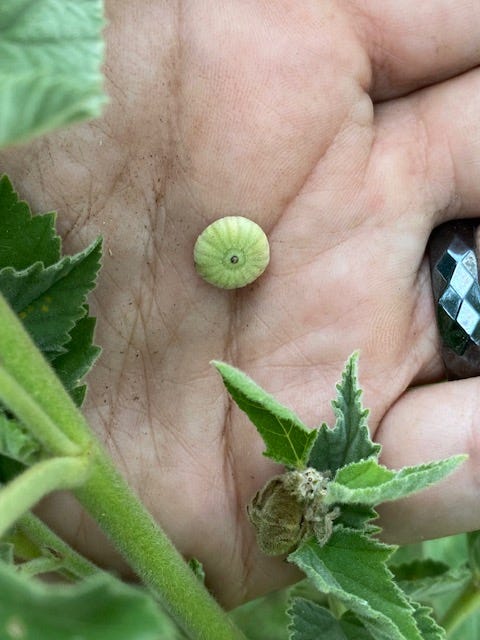
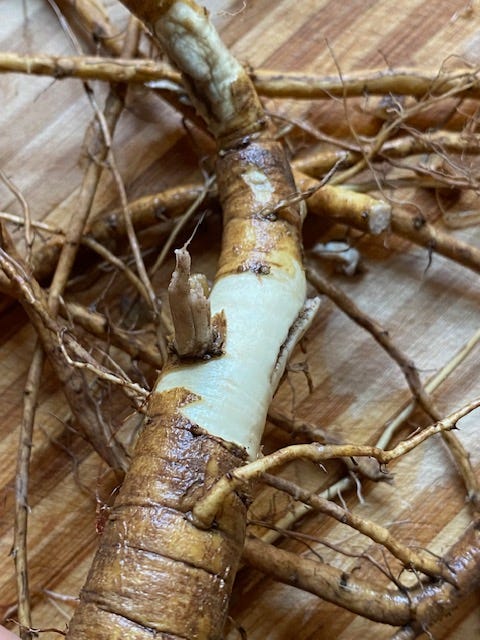
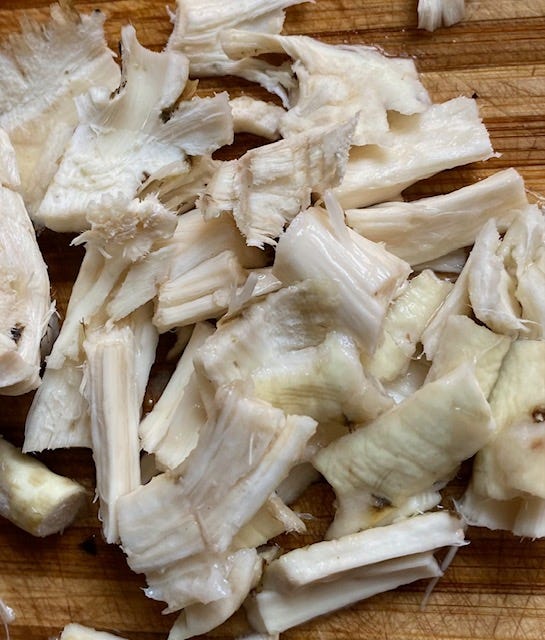


Love this!
I love your posts! Very informative. I starting growing marshmallow this year and if I can keep the mice from eating it I look forward to harvesting some leaves this year. I currently use Hollyhock and common mallow in my apothecary.